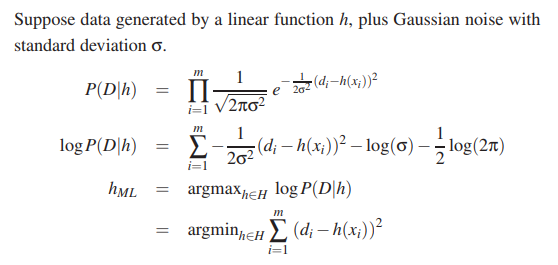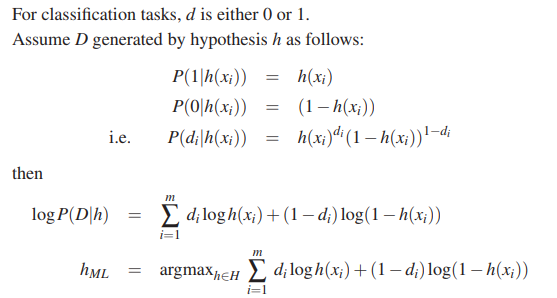Variations on Backprop
Variations on Backprop
Cross entropy
Problem: Least squares error function is unsuitable for classification, where target $t = 0\space or\space 1$
$E = \frac{1}{2}(z-t)^2$
Solution: Use a cross entropy error function (using maximum likelihood)
$E = -tln(z)-(1-t)ln(1-z)$
where t is 0 or 1. (Consider when actual z is close to t, E tends to 0)
Softmax Error
$P(i) = \frac{e(z_i)}{\sum_{j=1}^N e(z_j)}$
$E = -log P(i) = -(z_i - log \sum_j exp(z_j))$, where i is the correct class
Decrease $z_i$ if it’s the correct class, $log$ pushes up if it’s similar
Probability and Maximum Likelihood
- Gaussian Distribution: normal distribution where the sum of all values is equal to 1.
- $P(x)=\frac{1}{\sqrt{2 \pi} \sigma} e^{-\frac{1}{2\sigma^2}(x-\mu)^2}$
- Maximum Likelihood states that you should choose a hypothesis $h \in H$ such that it maximises the likelihood that the data D is generated under that hypothesis, e.g. $h_ML = argmax_{h\in H}P(D|h)$
For least squares:

For cross entropy:

- Bayes rule: probability of A given B: $P(A|B) = \frac{P(B|A)P(A)}{P(B)}$
- In machine learning:
- $P(D|h)$ = the probability of data D being generated under hypothesis h in all hypotheses
- $P(h|D)$ = the probability of hypothesis h is correct, given the data D was observed
- $P(h)$ is called the prior
Weight decay
- Small weights are more likely to occur than large weights
- So, penalise larger weights - increase error if large weight
$E = \frac{1}{2} \sum_i(z_i-t_i)^2 + \frac{\lambda}{2} \sum_j w_j^2$
- Therefore we reduce (‘decay’) the weight when we update them:
$w\leftarrow w - \eta \frac{\delta E}{\delta w} - \eta \lambda w$
Momentum
- Weights tend to oscillate without much improvement. Add a momentum factor before calculating the actual weights.
$\delta w\leftarrow \alpha \delta w + (1-\alpha)\frac{\delta E}{\delta w}$
$w\leftarrow w - \eta \delta w$
- This dampens sideways oscillations (gradient multiplied by $1-\alpha$), and amplifies downward motion by $\frac{1}{1-\alpha}$
Other Variations
- Conjugate gradients: compute secondary derivatives $\frac{\delta^2 E}{\delta w_i \delta w_j}$, approximate landscape with quadratic function and jump to minimum of quadratic function
- Natural gradients